To prepare braided hair for braids, start by washing and conditioning the hair to ensure it is clean and moisturized.
Whether you’re opting for classic box braids, cornrows, or intricate twists, proper preparation of the braided hair is essential for achieving long-lasting and flawless results. This involves taking care of the hair’s hygiene and ensuring it has adequate moisture.
By adhering to a simple yet effective routine, you can create a perfect base for your braids, ensuring they look breathtaking and stay intact for an extended period.
In the following sections, we will dive into the details of how to prepare your hair for braids effectively, leaving you with stunning results and healthy hair.
Know Your Hair Type for Perfect Braids: Tailoring Preparation to Your Hair’s Needs
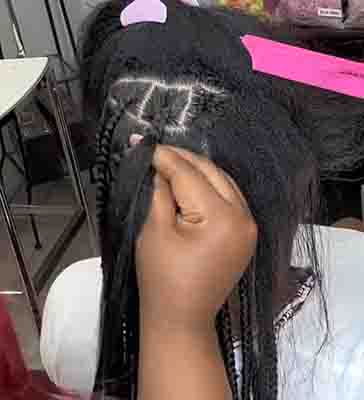
Before embarking on your braiding journey, it’s essential to understand your unique hair type.
Each hair type comes with its characteristics and requirements for optimal preparation.
Here’s a guide to help you prepare your hair according to its specific needs:
1. Straight Hair

- Characteristics: Straight hair tends to be smooth and lacks natural curls or waves.
- Preparation Tips: Use products that add volume and texture to give your braids a fuller appearance. Straight hair may benefit from a gentle wave or crimp for added texture.
2. Wavy Hair

- Characteristics: Wavy hair features gentle, natural waves or loose curls.
- Preparation Tips: Focus on enhancing the natural texture. Use lightweight, frizz-controlling products to maintain a defined wave pattern while preventing excessive frizz.
3. Curly Hair
- Characteristics: Curly hair has well-defined curls or coils that may range from loose to tight.
- Preparation Tips: Moisturizing products are your best friend. Curly hair can be prone to frizz, so hydrating and curl-defining products are essential to maintain your curls’ shape and prevent frizz.
4. Coily Hair
- Characteristics: Coily hair consists of tightly coiled curls or coils with minimal natural oils.
- Preparation Tips: Prioritize moisture retention. Deep conditioning and using rich, hydrating products are crucial to prevent dryness and maintain coil definition.
5. Thick Hair
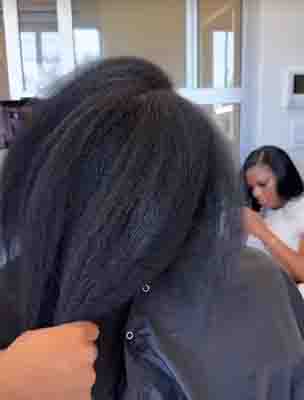
- Characteristics: Thick hair contains a high density of hair strands, making it voluminous.
- Preparation Tips: Focus on detangling and sectioning your hair properly before braiding. Use lightweight styling products to ensure your braids are manageable.
6. Fine Hair
- Characteristics: Fine hair has thin individual strands, which may appear flat.
- Preparation Tips: Use products that add thickness and volume to your hair, making it easier to work with and ensuring your braids have a more substantial appearance.
Guide to Preparing Your Hair for Braiding: A Step-by-Step Approach
Preparing your hair for braiding is a crucial step to ensure that your braids not only look fantastic but also promote the health and strength of your natural hair.
Here’s a comprehensive guide on how to prepare your hair for braiding:
1. Wash and Condition

Start with clean hair. Use a gentle, sulfate-free shampoo to cleanse your hair thoroughly.
Follow up with a hydrating conditioner. Focus on the lengths and ends of your hair to ensure it’s adequately moisturized.
2. Detangle and Remove Knots
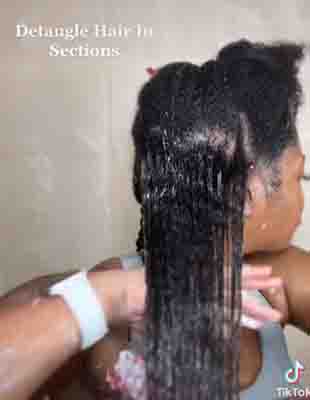
Gently detangle your hair using a wide-tooth comb or your fingers. Start from the tips and work your way up to the roots.
Removing knots and tangles not only makes the braiding process smoother but also prevents damage.
3. Moisturize and Nourish
Apply a high-quality leave-in conditioner or hair oil. Choose a product that suits your hair type and provides long-lasting moisture.
Pay attention to your hair’s needs. Curly and coily hair types may require richer, creamier products, while straight or fine hair can benefit from lightweight sprays or serums.
4. Strengthen and Trim
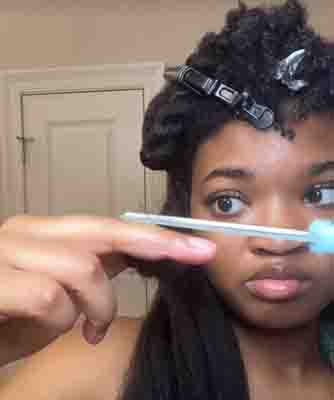
Trim split ends. Regular trims help maintain the health of your hair and ensure your braids stay neat and free from frizz.
Focus on the ends of your hair, as split ends can travel up the hair shaft if left unattended.
5. Section and Part
Depending on your braiding style, section and part your hair accordingly. Use hair clips or bands to keep sections separate and organized.
Create clean, straight parts to achieve neat and uniform braids.
6. Scalp Care
Pay attention to your scalp. A clean and well-moisturized scalp provides a healthy foundation for braiding.
If your scalp is prone to dryness or flakiness, consider using a scalp oil or treatment.
7. Protect and Cover
If you have a sensitive scalp or plan to wear extensions, consider using a scalp protectant or anti-itch product.

Protect your hair overnight by wrapping it in a satin or silk scarf or using a silk pillowcase to prevent frizz and breakage.
8. Be Gentle
Throughout the entire process, handle your hair gently to minimize stress and damage.
Avoid excessive heat styling or chemical treatments before braiding, as this can weaken the hair.
9. Consult a Professional
If you’re unsure about preparing your hair or have specific concerns, consult a professional stylist who specializes in braiding.
Tips for Protecting Your Scalp and Hairline When Preparing for Braids
1. Apply a Protective Oil or Serum
Before braiding, apply a protective oil or serum to your scalp. Choose products that contain natural ingredients like jojoba oil, castor oil, or aloe vera.
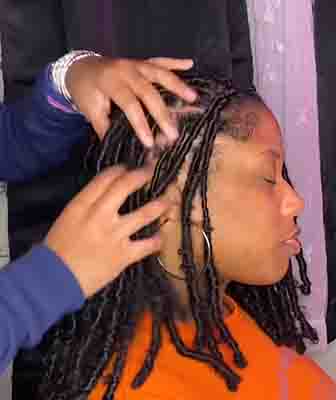
Gently massage the oil into your scalp to nourish and moisturize the hair follicles. This helps prevent dryness, itching, and breakage.
2. Minimize Tension on the Hairline
Be mindful of the tension applied to your hairline during the braiding process. Excessive pulling and tight braids can lead to hair damage, thinning, and even hair loss.
Communicate with your stylist to ensure they’re aware of your comfort level, and don’t hesitate to speak up if the braids feel too tight.
3. Avoid High Tension Styles
Consider the style of braids you’re getting. Certain styles, like tight micro-braids or high-tension cornrows, can put excessive stress on your hairline and scalp.
Opt for looser, less tension-inducing styles if you have concerns about hairline protection.
4. Hydration and Diet
Stay hydrated by drinking plenty of water, as this contributes to overall hair health. A balanced diet rich in vitamins and nutrients also promotes strong, healthy hair.
Consider taking hair supplements if you have specific hair health concerns.
Creating the Ideal Braiding Base: A Step-by-Step Guide
Before you embark on your braiding journey, it’s essential to create the perfect braiding base.
This foundational step significantly influences the quality and longevity of your braided hairstyle.
Here’s a step-by-step guide to help you prepare your hair for braids:
1. Section Your Hair Strategically
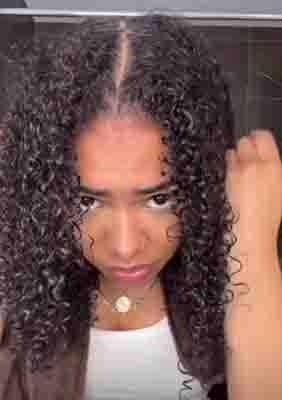
Begin by sectioning your hair into manageable parts. Smaller sections are ideal for intricate braiding styles, while larger sections work well for chunkier braids.
2. Stretch or Straighten Your Hair (Optional)
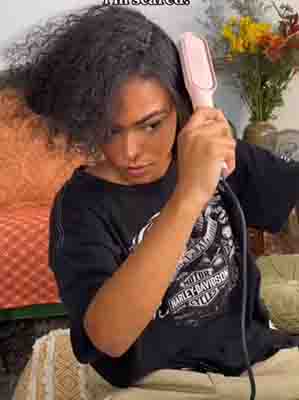
Depending on your desired final look, you may choose to stretch or straighten your hair before braiding. This step is optional and largely depends on personal preference.
If you opt for stretched or straightened hair, use a heat protectant spray and a flat iron or blow dryer with a comb attachment to achieve the desired texture.
3. Apply a Light Leave-In Conditioner
A lightweight leave-in conditioner helps detangle and moisturize your hair, making it more manageable for braiding.
Apply the conditioner evenly throughout your hair, paying special attention to the ends and any areas prone to dryness.
4. Choose the Appropriate Braiding Technique
The choice of braiding technique should align with your hair type and the desired final look.
For straighter hair types, consider a three-strand or two-strand twist technique. For curly or coily hair, twist-outs, braid-outs, or cornrows may work better.
Experiment with different techniques to find the one that suits your hair best.
5. Start Braiding
Begin braiding from the root or base of each section. Ensure that the braids are tight enough to stay secure but not overly tight to avoid causing tension and discomfort.
Maintain a consistent braiding pattern throughout to achieve a neat and polished look.
Safe Removal of Braids: Protecting Your Hair and Scalp
When it’s time to say goodbye to your braids, it’s essential to remove them carefully to avoid damaging your hair. Follow these steps for safe braid removal:
1. Pre-Treatment
Before starting the removal process, apply a moisturizing oil or conditioner to your braids. This helps lubricate the hair, making it easier to unravel without causing breakage.
2. Take Breaks Between Styles
Give your hair a break between braiding styles to allow it to recover. This helps prevent overexertion of the hair shaft and reduces the risk of breakage.
3. Be Patient
Removing braids can be time-consuming, so be patient. Rushing the process can lead to hair damage.
4. Gently Unravel
Begin the removal by gently unraveling the braids. You can use your fingers or a wide-toothed comb to separate the hair.
Avoid pulling or tugging too hard, as this can lead to hair breakage.
5. Assess Your Scalp
Pay attention to your scalp’s health during removal. If you notice any irritation or discomfort, take appropriate measures to soothe it.
7. Professional Help
If you’re uncertain about the removal process or encounter challenges, consider seeking the assistance of a professional stylist. They can safely and efficiently remove your braids while preserving the health of your hair and scalp.
8. Deep Conditioning
After removing the braids, treat your hair to a deep conditioning treatment to restore moisture and strength. This helps maintain the overall health of your hair.
Post-Braid Hair Care: Nurturing Your Natural Hair
Once your braids are removed, it’s time to give your natural hair some extra TLC to ensure its health and vitality. Follow these essential post-braid hair care steps:
1. Gentle Cleansing
Begin by gently washing your hair with a mild, sulfate-free shampoo. This helps remove any dirt, product residue, or buildup from your hair and scalp.
2. Regular Moisturizing:
Implement a regular moisturizing routine to keep your hair hydrated. Use leave-in conditioners, hair oils, or moisturizing creams to maintain softness and prevent dryness.
3. Protective Styles
Consider protective styling options that minimize manipulation and reduce the risk of damage. Protective styles include twists, braids, or buns.
4. Minimal Heat Usage
Try to avoid excessive heat styling during the post-braid phase. Heat can further stress your hair, which needs time to recover.
5. Avoid Tight Styles
When styling your hair, avoid tight hairstyles that can cause stress on the hairline and scalp.
6. Trim as Needed
Trim your hair as needed to remove any split ends or damaged sections. This promotes healthy growth and prevents further damage.
FAQ
Prepare your hair for box braids by washing, deep conditioning, detangling, and moisturizing it. Make sure it’s clean and well-nourished before braiding.
Yes, it’s generally recommended to wash your hair before braiding to ensure it’s clean and free from dirt and oils.
Washing your hair a week before getting braids is fine, but ensure your hair remains clean and doesn’t accumulate excess oils before the appointment.
New braids may feel tight initially. To break them in, gently pull and loosen the braids, avoiding excessive force to prevent damage.
To safely remove braids, apply a natural oil or conditioner to the braids before unraveling to reduce friction and minimize breakage.
Before getting box braids, avoid excessive heat styling, chemical treatments, and tight hairstyles to prevent damage to your hair.
For box braids, use synthetic or human braiding hair extensions that match your desired length and color.
Box braids are typically done with dry hair because it’s easier for the stylist to work with and ensures a more secure grip.
Soak braiding hair in white vinegar for about 15-20 minutes to remove any coating or residue before braiding.
Hair for box braids should be clean, dry, and well-conditioned. It’s typically divided into sections to create neat and even braids.
Prepare your hair for cornrows by washing, conditioning, and detangling it. Ensure it’s clean and moisturized before styling.
For beginners, it’s advisable to have someone else do your box braids. But if you want to try, practice basic braiding skills first and use a mirror for guidance.
The number of packs needed for box braids depends on your desired thickness and length. On average, 5-10 packs are often sufficient.
Not washing your hair before getting braids can lead to dirt and oil buildup, making it less pleasant for the stylist and affecting the quality of the braids.
Braiding your hair after washing can help it dry in a wavy or curly pattern, but ensure the braids aren’t too tight to avoid damage.
Braiding hair after washing can create waves or curls, but avoid tight braids to prevent damage.
Blow-drying is not necessary before braiding but ensure your hair is thoroughly dry if you choose this option to avoid frizz.
You can braid your hair immediately after washing and drying it, as long as it’s dry and free from excess moisture.
Gently brushing your hair after removing braids can help detangle and remove shed hair, but be careful to avoid excessive force.
To stretch hair before braiding, you can use heatless methods like banding, threading, or braiding your hair loosely before styling.
It’s not necessary to relax hair before braiding. In fact, braiding can be a protective style for those transitioning to natural hair.
To keep braids tight while braiding, maintain even tension on the strands and ensure consistent section sizes.
Practicing your braiding skills and using a good-quality comb, clips, and hair products can make braiding easier.
Tight braids may loosen slightly over time, but they should not be excessively tight to avoid damage.
You can stretch your hair without heat by using methods like banding, threading, or braiding it loosely before styling.
To prepare for knotless braids, wash, deep condition, and detangle your hair, and ensure it’s dry before the appointment.
Related Articles:
- Are Weaves Bad For Your Hair
- Where Did Braids Originate From? Know The True History
- What Are Bantu Knots
Conclusion
To wrap up, preparing your hair for braids is a crucial step to ensure a successful and long-lasting braided hairstyle. By following a few simple steps, you can ensure that your hair is in the best condition possible before starting the braiding process.
Begin by thoroughly washing and conditioning your hair to remove any product buildup and promote a healthy scalp. Next, moisturize your hair to prevent dryness and breakage, and detangle it carefully to minimize any potential damage. It’s also important to trim any split ends to maintain the overall health of your hair.
Lastly, consider using protective measures, such as applying an oil or heat protectant to your hair, to shield it from damage during the braiding process. By taking the time to prepare your hair properly, you can achieve stunning braided hairstyles that will turn heads and keep your hair healthy and strong.

